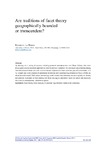| dc.contributor.author | La Barre, Kathryn | es_ES |
| dc.date.accessioned | 2013-11-29T11:06:03Z | |
| dc.date.available | 2013-11-29T11:06:03Z | |
| dc.date.issued | 2013 | es_ES |
| dc.identifier.citation | Actas del X Congreso de ISKO-España. Ferrol 20 de junio-1 de julio de 2011; 2013: 525-538. ISBN: 978-84-9749-535-6 | es_ES |
| dc.identifier.isbn | 978-84-9749-535-6 | es_ES |
| dc.identifier.uri | http://hdl.handle.net/2183/11637 | |
| dc.description.abstract | [Abstract]
By drawing on a variety of sources, including personal correspondence with Brian Vickery, this paper
draws upon a socio-historical approach in order to provide a platform for continued conversations among
facet theorists and those who seek to create faceted applications. Once common ground is established, it is
but a small step to the creation of operational definitions and functional requirements as Slavic (2008) and
others have discussed. With variant terminology under control, facet theorists can move quickly to identify
and promote exemplars of best practice for those seeking to implement facets as search and discovery
structures in contemporary information spaces. | es_ES |
| dc.language.iso | eng | es_ES |
| dc.publisher | Universidade da Coruña | es_ES |
| dc.subject | Facet theory | es_ES |
| dc.subject | Facet analysis | es_ES |
| dc.subject | Functional requirements | es_ES |
| dc.subject | Operational definitions | es_ES |
| dc.title | Are traditions of facet theory geographically bounded or transcendent? | es_ES |
| dc.type | info:eu-repo/semantics/conferenceObject | es_ES |
| dc.rights.access | info:eu-repo/semantics/openAccess | es_ES |






